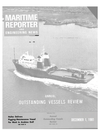
Page 42: of Maritime Reporter Magazine (December 1981)
Read this page in Pdf, Flash or Html5 edition of December 1981 Maritime Reporter Magazine
Papers On Containerships, Bulkers
Presented By SNAME California Sections meeting of the Northern and Southern California sections of SNAME, from
Roger Potash, chairman, Northern California section; Henry Kozlowski, mem-
L.A. Harlander, author; Art Haskell, member; Bob Herbert, member.
The world economy depends on the speedy, reliable transport of dry cargo across the oceans. Most of that cargo is carried either in drybulk carriers or container- ships, both of which are highly evolved forms of ocean transport.
Two technical papers focusing on the development of these ships were presented before a recent joint meeting of the Northern and Southern California sections of The Society of Naval Archi- tects and Marine Engineers, held at the Carmel Highlands Inn,
Carmel, Calif.
Clyde Jacobs, president of Sea- board Shipping Co. Ltd., Van- couver, British Columbia, Cana- da, presented a paper entitled "The Development of the Special- ized Dry Bulk Carrier." It traced the evolution of this vessel type from the earliest steel ships of the 1890s to the contemporary designs specialized to carry lum- ber, automobiles, woodchips, or newsprint. Mr. Jacobs presented evidence of a trend toward more fuel efficient ships operating at slower speeds.
L.A. Harlander, vice president of operations, American Presi- dent Lines, Oakland, Calif., pre- sented a detailed discussion of "Container System Design De- velopments Over Two Decades," in which he emphasized the cru- cial role of container standard- ization in the design of container systems. Mr. Harlander asserted that current container strength standards are excellent, and that below-deck container storage has reached an optimum level of de- velopment. On-deck stowage schemes, he contended, still re- quire improvement.
Copies of the papers may be obtained by contacting R. Keith
Michel, Papers Committee, Her- bert Engineering, 88 First Street,
San Francisco, Calif. 94105.
An artist's concept of huge liquefied natural gas-carrying submarine tanker oper- ating under Arctic ice. Loading at undersea terminals, tanker fleet would transport
LNG from Prudhoe Bay, Alaska, to ice-free ports in Canada and Europe.
Submarine LNG Carrier Proposed
By General Dynamics For Arctic Regions
Two veteran shipbuilders have combined their knowledge of sur- face ship, submersible and cryo- genic technology to propose trans- porting liquefied natural gas (LNG) from the Arctic by sub- marine tanker.
P. Takis Veliotis, General Dy- namics' executive vice president- marine and general manager of its Electric Boat Division, and
Spencer Reitz, Electric Boat dep- uty general manager, outlined their proposal in a technical pa- per presented before the recent
Gastech '81 LNG/LPS Confer- cTuna
Delight
Jm >H r 1 *
Tuna Delight x
Take one 20 cyl. engine . envelope in a steel hull, add auxiliaries, fish wells and outfitting. Season with Burton expertise, then cook for 15 months at Burton Shipyard until well done. Boat is then ready to serve on Captain and crew . a perfect TUNA DELIGHT. (Note: Seven dishes ordered by Van Camp Sea Food Co. Two delivered— Carol
Linda & Patrician. Five still cooking at Burton).
Get your personal recipe for the most modern dependable and efficient purseiner on the market.
Contact ft. C Moerbe at:
Burton Shipyard, Inc.
P.O. Box 3636. Port Arthur. Texas 77640
Telephone: (713) 962-5705 • Telex: 779-403 ence and Exhibition in Hamburg,
Germany.
Electric Boat is a leading de- signer and builder of submarines for the U.S. Navy. A sister divi- sion, Quincy Shipbuilding, is a leader in surface LNG tanker de- sign and technology. The paper, "A Submarine LNG Tanker Con- cept for the Arctic," explores the technical feasibility and economic viability of the submarine LNG tanker concept for the Arctic.
The authors assert that the pri- mary advantage offered by a sub- marine system over a surface ship system is the ability to de- liver a constant cargo volume at uniform, predictable schedule in- tervals the year-round, regard- less of surface ice and weather conditions.
Mr. Veliotis and Mr. Reitz say that the submarine concept would be competitive ecnomically with a surface icebreaking tanker sys- tem and considerably lower in cost than a pipeline system.
The shipbuilders are proposing two versions of the tanker, one nuclear powered, the other con- ventional. The nonnuclear ver- sion, which would burn methane in supercharged boilers to power huge turbines, would be 1,470 feet long. The nuclear version would be 200 feet shorter. Each would have a beam of 228 feet and a depth of 92 feet. They would be operated by a crew of 32.
The ships would carry the LNG in six 341-foot cylindrical cargo tanks with a total volume of 140,- 000 cubic meters. The tankers would load the fuel in Prudhoe
Bay at submerged cargo stations and unload at surface terminals in an ice-free Canadian port — via the Parry Channel — or at a
European port.
Projected cost per ship would be $700 million for the nonnu- 60 Write 537 on Reader Service Card Maritime Reporter/Engineering News

 41
41

 43
43
